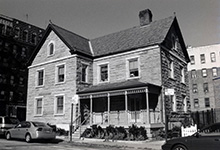 Fordham University has begun clearing the necessary hurdles to build a new radio antenna on a Norwood apartment building for its public radio station, WFUV. If successful, Fordham would finally put an end to a decade of controversy, which began when it started to construct a tower on its campus, which infuriated its institutional neighbor, the New York Botanical Garden.
Fordham University has begun clearing the necessary hurdles to build a new radio antenna on a Norwood apartment building for its public radio station, WFUV. If successful, Fordham would finally put an end to a decade of controversy, which began when it started to construct a tower on its campus, which infuriated its institutional neighbor, the New York Botanical Garden.
Fordham completed an environmental impact assessment for the project last Friday for the Montefiore II residential high-rise, located at 3450 Wayne Ave. at Gun Hill Road, which would host the 142-foot tower on its roof. Fordham contends that there would be little, if any, impact on local health, aesthetics and radio interference.
“We’re hopeful that we’ll be able to adequately address all concerns,” said Joe Muriana, Fordham’s associate vice president of Government Relations and Urban Affairs.
Local officials and Community Board 7 will have 30 days to comment before the assessment is sent to city and federal agencies.
If the site proposal survives such scrutiny, it would permanently bury the longstanding feud between Fordham and the Garden over the university’s existing structure. Many argue that the 260-foot uncompleted tower, located near Southern Boulevard, mars the views inside the Garden. Fordham would dismantle the structure once the new one is built.
Montefiore proudly announced last May that it was offering Montefiore II’s roof, currently home to smaller antennas, as a solution to the intractable standoff. “It seemed to us that perhaps Montefiore could be of help, and if we could, we should,” said Spencer Foreman, MD, Montefiore’s president, during a press conference last May.
The controversy first began in 1994 when Fordham responded to new Federal Communications Commission (FCC) standards by building a radio tower on its campus. Fordham also wanted WFUV (90.7 FM), a well-respected music station, to reach more listeners throughout the metropolitan area.
Once the metal tower rose above the tree line, the Garden appealed to halt further construction, ushering in years of hearings, negotiations and court rulings.
Under the current proposal, which most state and city officials support, Montefiore would rent the space to Fordham for $100,000 a year. Once a cooling system is removed from the building’s penthouse, the slimmer and shorter structure would rise from the building’s rafters. According to Steve Osborne, a Montefiore spokesperson, the Medical Center intends to dismantle the cooling system by February.
Fordham employed Montefiore II’s original architect, along with a large team of engineers, to study the feasibility of the tower design. “We have been doing a lot of extra work on the engineering component,” Muriana said. Communications Technologies, designer of antennas for the Empire State Building and other major structures, is the architect.
To complete the impact assessment, Fordham hired AKRF, an environmental consulting firm previously used by both Fordham and Montefiore. The review examines possible impacts in five different areas, including interference and visual and health effects.
Because the tower can’t disturb Montefiore’s sensitive medical equipment, Fordham followed far stricter guidelines for safety and interference, according to Muriana.
“It’s especially designed so you can sunbathe on the roof and won’t be affected by it,” he said.
Though Fordham says the antenna is unlikely to disturb local reception of other radio stations, it intends to provide assistance to those experiencing problems.
But the tower will have a visual impact. It will appear prominently within a five-block radius and be visible for up to a half a mile, though Muriana contends it will look like “a toothpick” from that distance.
Members of the 204th Street/Bainbridge Avenue Merchants Association expressed concerns about the visual impacts when the project was first announced. Anthony Rivieccio, the association’s president, said merchant opposition mellowed after viewing a mock-up of the tower’s design. “If it goes according to that plan, we hope it works and life will move on,” he said.
Muriana contends that residents will quickly get used to the slim structure. “People probably won’t notice it within seven or eight months after it’s up,” he said.
After the Community Board makes comments, the impact statement is assessed by the city Board of Standards and Appeals, which must schedule a public hearing before issuing the project a special permit. The FCC and the state Office of Parks, Recreation and Historic Preservation must then give their approval.




